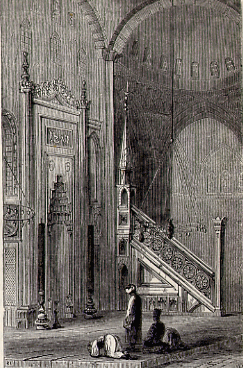
19th century Cairo mosque illustration from Henry Van-Lennep’s Bible Customs.
Those of us who spend hours using Arabic lexicons would be at a loss without the massive Tâj al-‘Arûs min jawâhir al-qâmûs of Muhammad Murtadâ al-Zabîdî. Completed by this consummate Muslim scholar in 1188/1774 after fourteen years of diligent research, the recent Kuwait edition comprises 40 volumes. Ironically, what took al-Zabîdî fourteen years to write and dictate seems a rapid turn-around, given that the Kuwait edition began in 1960 and was not completed until 2002 [There is a copy available for only £2,463 from Abe Books…, but I suggest you go to Lebanon, where the 40 volume set is only $325 from Fadak Books I am not aware of any online version of Tâj, although Lisân al-‘Arab is available online in searchable format.] Those of us who could never afford to house the 40 volume edition have managed to get by with reprints of the 19th century Cairo edition, funky font presence that it sheds. I remember buying my copy of the thick black-cover volumes in 1981, filling a suitcase with the hefty weight, paying the porter a handsome bakshish for his back-breaking effort at Cairo airport, and then having the suitcase implode from the weight as I crossed the threshhold of my home back in New York. I like to think that my own account would have made its way into al-Zabîdî’s inquisitive notes.
The German scholar Stefan Reichmuth has recently published a superb biographical and bibliographical study of al-Zabîdî, whose lexicon has long overshadowed his other literary contributions. This is The World of Murtadâ al-Zabîdî (1731-91): Life, Networks and Writings (Oxford: Oxbow Books, Gibb Memorial Series, 2009). Reichmuth has produced a model study about one of the most important Muslim scholars of the 18th century, a man who taught ‘Abd al-Rahman al-Jabartî, and an individual whose life spanned the intellectual span right before Napoleon’s ill-fated invasion of Egypt. The lexicon itself receives an entire chapter in Reichmuth’s study, as befits a work that the author thought would make all previous lexicons irrelevant and a work that was essential for Lane’s Arabic-English Lexicon. But al-Zabîdî composed well over 200 works, especially relevant for hadîth studies and biographical notices. It is perhaps noting that he was also a Naqshabandî Sufi and had a wide range of acquaintances among scholars and the political elite.
There is much to learn in Reichmuth’s erudite, yet eminently readable, study. I had previously been unaware that the author of the text I resort to over and over again for Yemeni usages was in fact born in India and only spent five years in coastal Yemen. Obviously he was a scholar with both a good memory and a work ethic to be emulated. For a book of this caliber the price tag (around $86 on Amazon) is worth it. No major university library should be without this book and this is one of those reference books that is worth investing in for your own personal library, as it fills in a major gap in our undertsanding of the continuing “humanism” of Muslim scholars before the oft-proclaimed start of modern Orientalism.
Here is what his student al-Jabartî said about his master:
He was a monumental figure, a wizard who played with the minds. He had traversed all the paths of language and tradition and dived into the deepest realms of knowledge. The ways of speech were under his sway, and pages and pens bore witness to him. A man of erudition and kindness and also a recognized landmark [of science], he was a most judicious authority and a goal for travellers, a genealogist, jurist, traditionist, lexicographer, grammarian, legal theorist, and a writer of poetry and prose.
What a fitting epitaph in any era.
Daniel Martin Varisco